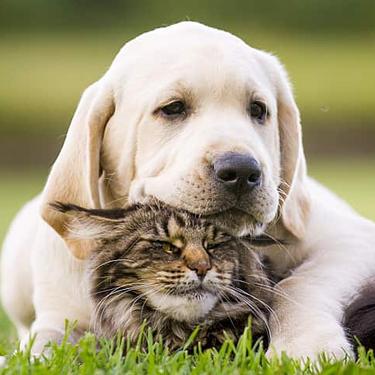

In their range of size and appearance, dogs are one of the most diverse species on the planet. It can be hard to believe the tiny Chihuahua and the giant Great Dane are almost identical on a genetic level. But their vastly different ears, paws, and temperaments are largely due to selective breeding by humans.
Just how many dog breeds are there? Also, what does it take to get a new type of dog listed as an official breed? Keep reading for the answers to your burning questions about all breeds of dogs.
Dog Breed Governing Bodies
The Fédération Cynologique Internationale (FCI), also known as the World Canine Organization, is an international federation of kennel clubs from 84 countries worldwide, excluding the United States, the United Kingdom, and Australia. In these countries, the respective governing bodies for determining dog breeds and breed standards are the American Kennel Club (AKC), British Kennel Club (KC), and Australian National Kennel Council (ANKC). These organizations are responsible for determining which dogs meet the qualifications of a breed, as well as for establishing and enforcing breed standards in each of the regions they serve.
Establishing a Dog Breed
It's a fairly long road for a new type of dog to become an established breed. The various breed associations may differ slightly on how they determine the recognition of a new breed. However, they all generally follow the model of the AKC, which requires that there is a significant enough population of a particular type of dog and enough national interest to justify breed recognition. Establishing a breed also means looking out for the health and characteristics of that kind of dog and establishing rules to make sure breeders are raising healthy dogs safely and ethically.
Before the AKC considers a new breed for purebred status, the new breed must have a population of at least 300 to 400 dogs, spanning a minimum of three generations. There must also be a national kennel club devoted to this new breed that includes at least 100 members spread out over no fewer than 20 states. The club must also have an established set of standards and qualifications that a dog must meet to be considered part of the breed.
Once a national breed club meets all of the above qualifications, it can apply to the AKC for official breed status. If approved, the breed can then compete in the "miscellaneous" class in AKC-affiliated dog shows. Typically, after competing in this class for at least three years, the AKC board of directors reviews the breed to determine eligibility and whether to grant full recognition and official breed status. While the number of new breeds added to the AKC registry varies from year to year, 25 new breeds have been granted official status since 2010.

A great looking coat attracts more petting
Pets benefit from looking good, too. Make sure your dog's fur is its finest. With our science-led Braised Beef, Carrots & Peas Stew Dog Food.
A great looking coat attracts more petting
Pets benefit from looking good, too. Make sure your dog's fur is its finest. With our science-led Braised Beef, Carrots & Peas Stew Dog Food.
Dog Breed Classifications
All of the major breed governing bodies classify dog types into groups based on the job the dog was originally bred to do. The AKC groups all dog breeds into seven categories:
Sporting - This group includes dogs that were bred to help hunt birds, such as ducks and geese. For this reason, the AKC and ANKC call the same group "gundogs." This group includes retrievers, such as the Labrador, Spaniels, and the Irish setter, as well as other setter breeds.
Hound - The hound group includes both sighthounds, such as the Afghan hound and Irish wolfhound, and scent hounds, like the bloodhound and the beagle. Hound breeds were generally bred to track both large and small game. Today, some work to find missing children, locate earthquake victims under rubble, and even sniff for damaging insects in paintings, according to ArtNet.
Terrier - Dog types in this group were initially bred to help control the rodent population. Stout and energetic, smaller terriers would burrow after rats and other rodents, while the larger breeds tended to dig up the nests of their prey. Many bear the name of the place they originated, such as Cairn or Staffordshire.
Herding - Herding breeds were originally bred to help control livestock, such as sheep and cattle. They tend to be agile and intelligent, easy to train, and responsive to human commands. This is why some herding breeds, such as the German shepherd, also make excellent police, military, and search and rescue dogs.
Working - Working breeds are those bred to perform specific jobs that don't involve hunting or herding. This includes sled dogs like the Siberian husky, search and rescue dogs like the St. Bernard, and larger breeds like the Rottweiler, which the Rottweiler Club of the United Kingdom says was bred to guard cattle being driven to market.
Non-sporting - This group is for breeds that aren't easily categorized into the other groups. Non-sporting dogs include the Dalmatian, the Poodle, and the Chow Chow, as well as other dogs bred simply for companionship or to perform roles that don't fall under the other main categories.
Toy - The toy group includes all of the tiniest breeds. Some, such as the Yorkshire Terrier (terrier group) or the Toy Poodle (non-sporting group) would be classified elsewhere if not for their diminutive size. Generally, under 10 pounds, these are lapdogs bred primarily for companionship.
How Many Dog Breeds Are There?
There is a wide number of dog breeds. In the United States alone, the AKC's dog breed list currently includes 200 dog breeds. Worldwide, the FCI lists 360 officially recognized breeds. These don't include experimental breeds that have yet to achieve official status. Official lists also don't include mixed-breed dogs, not even "designer" crossbreeds like the Goldendoodle (a cross between a Golden Retriever and a Poodle) or the Puggle (a mix of Beagle and Pug).
As cute and as popular as these hip new pups are, the fact that they're mixed breed dogs with no established standards outlining their appearance and characteristics for health disqualifies them for purebred certification. As with any wildly popular breed, prospective parents should work to make sure a puppy is healthy and a breeder is ethical before purchasing a dog. And all breeds of dogs that wind up at your local animal shelter could end up being your forever friend.
With eight more breed hopefuls currently listed in the AKC's miscellaneous class and enterprising dog breeders continuing to experiment with creating new varieties, the number of dog breeds is ever-expanding. But at the end of the day, whether a dog belongs to an officially recognized breed or is a mashup of a dozen different mutts makes no difference to their capacity to love you and make a fantastic pet.




















